#Eppler
Explore tagged Tumblr posts
Text
Gottesdienste um Epiphanias
Die evangelische Kirchengemeinde Bebenhausen lädt Sie zu Epiphanias herzlich zum Gottesdienst in die Klosterkirche Bebenhausen ein. Näheres entnehmen Sie bitte dem nachfolgenden Gottesdiensthinweisen. Bitte benutzen Sie den ausgeschilderten Parkplatz. ****************************************** Samstag, 6. Januar 2024 – Erscheinungsfest 11.00 Uhr Gottesdienst in der Klosterkirche (Pfarrerin…

View On WordPress
1 note
·
View note
Text
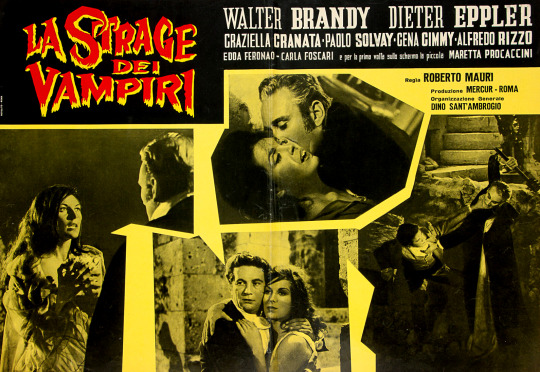

La strage dei vampiri (1962) - Italian photobustas
AKA Curse of the Blood Ghouls, Curses of the Ghouls, Slaughter of the Vampires
#la strage dei vampiri#slaughter of the vampires#curse of the blood ghouls#walter brandi#dieter eppler#graziella granata#1960s horror#1960s movies#1962#roberto mauri#gothic horror#photobusta#horror movie poster
38 notes
·
View notes
Text
Die Freiheit zu schweigen ist Teil der Redefreiheit.
The freedom to remain silent is part of the freedom of speech.
Erhard Eppler (*1926), German teacher and politician
80 notes
·
View notes
Text

Western Bobcat | John Eppler
4 notes
·
View notes
Text





tatort 108: kein kinderspiel, theo mezger 1980
youtube
viva zwei, fast forward 2000: charlotte roche interviews blixa bargeld
#tatort#kein kinderspiel#theo mezger#1980#werner schumacher#frank strecker#angelika bender#karl-heinz von hassel#julia hainzl#michael struebin#friedrich g. beckhaus#wilm roil#werner schulze-erdel#johannes grossmann#dieter eppler#rolf schimpf#ernst specht#morgens um sieben ist die welt noch in ordnung#eraserhead#material#buw#viva zwei#fast forward#2000#charlotte roche#blixa bargeld#silence is sexy#einstürzende neubauten#obst & gemüse oder der kunde ist könig
2 notes
·
View notes
Text

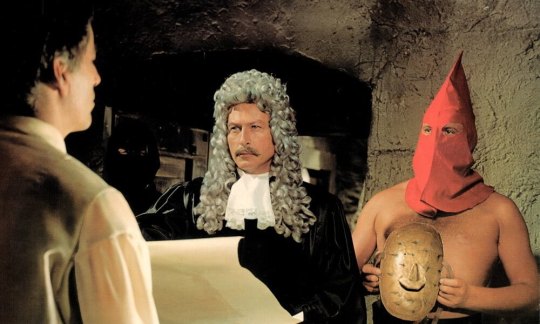

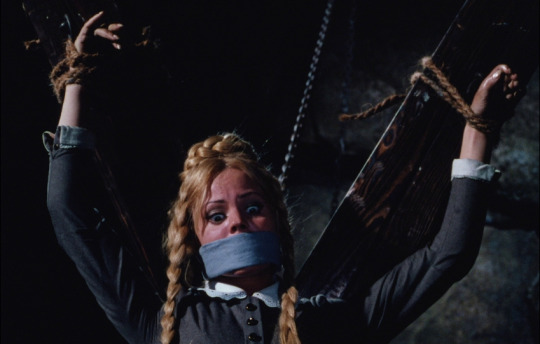
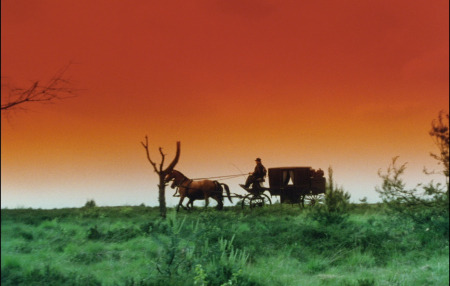

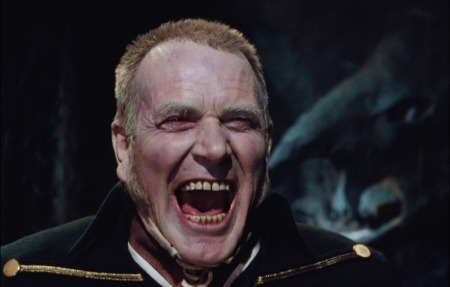


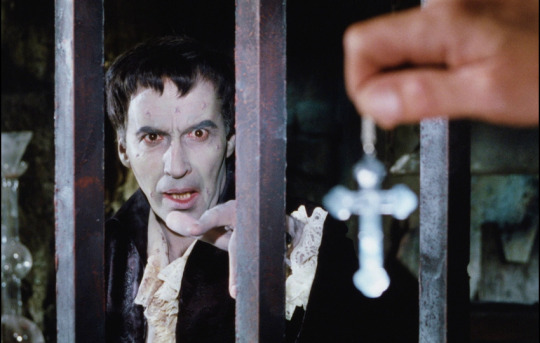
Die Schlangengrube und das Pendel (The Torture Chamber of Dr. Sadism, 1967)
"I'm already dead, hanged. Yes, I was hanged. Your body soon adapts a resistance to bullets."
"But, sir, I've not done anything wrong!"
"Of course not. All you did was shoot me somewhat."
#Die Schlangengrube und das Pendel#The Torture Chamber of Dr. Sadism#the blood demon#horror imagery#west german cinema#1967#harald reinl#manfred r. köhler#lex barker#karin dor#christopher lee#carl lange#christiane rücker#vladimir medar#dieter eppler#peter thomas#edgar allan poe#this ended up being quite a lot better than I'd anticipated; I'd figured it for a Jess Franco style bit of eurosploitation trash but#underneath its derivative plot‚ heavy cribbing‚ small cast and strained budget‚ there's an altogether more polished bit of kino going on#in particular‚ this looks fantastic: the set design‚ lighting‚ aesthetics‚ costuming‚ all are working hard to elevate this above its pulpy#genre origins. Bosch stype frescos‚ rich colourful tableaux‚ dripping gothic atmosphere.. on vibes alone this is a real winner#Lee is high in the credits of course but only really has an extended cameo (this being during his sojourn to europe to escape Hammer for a#while‚ only to end up making even cheaper Hammer alikes for the Germans and Italians). the plot is all Corman Poe cycle‚ loosely inspired#by the works of Poe‚ but with its own nearly wholesome adventuring bent. benefits from having genuinely likeable and compelling characters#upfront (Medar is a consistent scene stealer as a highway robber who gets unwillingly pulled into the gothic shenanigans and becomes a#reluctant heroic accomplice). some startling imagery and a few choice pearls of dialogue too. much better than it would look on paper#definitely one of the better examples of euro schlock from this era‚ and among the best Lee was involved in
14 notes
·
View notes
Text
Speech Kamala Harris gave in Dallas, TX!

~BR~
#kamala harris#tim walz#harris walz 2024#campaigning#policy#2024 presidential election#legislation#united states#hq#politics#democracy#harris walz 2024 campaigning#Texas#Dallas#beto o'rourke#deb haaland#stacey plaskett#colin allred#Sam Eppler#border security#women's rights#climate change#food insecurity
2 notes
·
View notes
Text
Showalter Done Managing Mets After This Season
Manager Buck Showalter has informed reporters that he will not be returning as the team’s manager in 2024. Mike Puma’s tweet, however, might shed a bit more light on what would’ve happened if he’d not have done so. While Showalter managed to become a fan favorite, not only standing up for his players against other teams after being drilled continuously, but also against the MLB when it seemed…

View On WordPress
#Billy Eppler#Buck Showalter#David Stearns#LGM#Mets#MLB#MLB Central#MLB Network#MLB Now#New York Mets#Pete Alonso#Sandy Alderson#Steve Cohen
6 notes
·
View notes
Audio
Your hosts travel to West Germany for DIE NACKTE UND DER SATAN (1959) from writer/director Victor Trivas!
What's been happening in Germany since our last horror movie there in 1936? Is there cultural significance to our villain having blonde hair and blue eyes? Listen and find out!
Context setting 00:00; Synopsis 39:19; Discussion 52:11; Ranking 1:13:56
#podcast#west germany#history of germany#horror#victor trivas#rapid-film gmbh#horst frank#michel simon#wolf hartwig#willy mattes#george krause#friedel buckow#karin kernke#christiane maybach#dieter eppler#helmut schmid#paul dahlke#kurt muller-graf#german horror#post war germany#post war cinema#theo nischwitz
4 notes
·
View notes
Photo

“The Vanguard of the Chinese Division,” 1898. Photograph by Isaiah West Taber for The Wave magazine (vol. XVII, no. 5), January 29, 1898. The Chinese contingent of the Golden Jubilee Procession of 1898 turning westerly from Kearny onto Market Street.
Crashing the Party: When SF’s Chinese Road-tested Parade Strategy for Civic Celebrations
The Chinatown community’s celebration of the Lunar New Year with the rest of the San Francisco Bay Area on a rain-soaked evening in February, 2023, serves as a reminder about why the annual institution of the parade exists at all.
Parades and public events have been used throughout history as a means of promoting community identity and expressing political or social views. As I have written elsewhere, the modern version of the Chinese New Year parade traces its beginning to 1953 when a handful of Chinatown’s business elite designed that year’s Lunar New Year parade to represent more than an ethnic festival.
“There were grave concerns that the Chinese will be rounded up and put in camps,” cultural historian David Lei told NBC News back in 2018. “Memories of the mass incarceration of Japanese Americans during WW II were fresh in the minds of Chinatown’s leaders. By 1949, the Chinese were the enemies because China became Communist … [s]o this was their platform to do some good for the community. It was to survive in Chinatown. Tourism was a big thing, so this was a big tourism push.”
The sponsors of the 1953 parade deliberately reminded participants of Chinese Americans’ loyalty to the United States, the community’s anti-communist sentiment, and their efforts to reach out to mainstream American society during the Korean War. Chinese American veterans of World War II and the Korean War marched at the front of the parade in validation of the community’s patriotism.
The political and business calculations of 70 years ago may have comprised the impetus for staging the public event. However, the modern parade also represented a revival of the parade as a tested public relations strategy learned by the urban Chinese pioneers throughout the last half of the 19th century to take advantage of the natural curiosity and interest of non-Chinese in the community’s festival life.

“Chinamen Celebrating Their New-Year’s Day in San Francisco” (Harper’s Weekly, March 25, 1871) from the collection of the California Historical Society. The accompanying article reads in part as follows: “Our illustrations on page 260 will give the reader a vivid idea of the way in which the Chinese keep their New-Year’s Day in San Francisco. Their year commences on the 18th of February, but the festivities continue for several days, to the great annouyance [sic] of the poeple [sic], as the principal diversion is the constant explosion of fire-crackers and bombs. Some rather amusing as well as annoying incidents occurred during the festival, as shown by our artist in the street scene. One unhappy man, driven wild by the racket in front of his house, tries to drive off his annoyers by throwing water on the crowd; and some ardent specimens of Young America are engaged in a hand-to-hand tussle with young heathen Chinese, whose pigtails afford a point d'advantage of which the young rascals make full use.”
This year’s Chinese New Year parade marks not only its 70th year but also the 125th anniversary of the San Francisco Golden Jubilee parade of 1898 -- one of the earliest examples of Chinese participation in a citywide event to gain recognition and acceptance as a part of American society.
The purpose of the San Francisco celebration of the Golden Jubilee of 1898 was to commemorate the 50th anniversary of the California Gold Rush of 1848 and to celebrate the city's growth and prosperity. The event was organized as a parade and featured a variety of floats, bands, and other attractions, showcasing the city's cultural and economic achievements. The Golden Jubilee was seen as an opportunity to celebrate the city's past and to look ahead to its future with optimism and hope. The event marked a significant moment in the history of San Francisco and an affirmation of the city's place as a thriving center of commerce, culture, and innovation.
Historian Mark Robertson wrote about the Golden Jubilee in 2012 as follows:
“California’s Golden Jubilee and Mining Fair (CGJ) was held in San Francisco from January 24 to March 5, 1898. In the midst of the accelerating Yukon gold rush, a rebounding regional economy, and San Francisco’s growing preeminence on the Pacific, a disparate coalition of associations representing San Francisco’s “commercial-civic elite” transformed a private legacy of commemoration into a mass civic celebration.[1] The legacy of remembering James W. Marshall in San Francisco reveals that as the anniversary approached, conflicting imaginings of the city’s past and future were made to be reconciled for the sake of shared civic gain. By looking at the ways in which the ideas of profit and promotion prompted the coalition of commercial-civic elite in 1897-98 (led by Mayor and politician James D. Phelan and flanked by the San Francisco Miners’ Association, the Society of California Pioneers, and the San Francisco Merchants’ Association) to transform this small, parochial private commemoration of James W. Marshall’s discovery of gold into a mass civic celebration of San Francisco’s economic growth, social development, and the city’s position in an expanding American empire, we can better understand how massive celebrations like the CGJ reinforced and reoriented California’s Pioneer Myth within the context of a new international mining frontier and the city’s progressive insurgent leadership of the late 1890s. . . .”
In the late 19th century, the Chinese residents of San Francisco faced significant challenges, including racial discrimination and exclusionary laws such as the Chinese Exclusion Act of 1882. The Golden Jubilee parade provided an opportunity for the Chinese to showcase their cultural heritage and demonstrate their loyalty to the United States, despite facing challenges and discrimination. As plans for the Jubilee proceeded apace, the San Francisco Call reported in its January 18, 1898, issue about Chinese interest in its parade as follows:




As a close-knit and well-organized community, the Chinese community’s participation in the parade represented a collective effort under the apparent umbrella of a “United Parlor of the Native Sons of the Golden State.” They put together a colorful and elaborate float, which featured traditional Chinese dragon and lion dances, and was designed to demonstrate the beauty and richness of Chinese culture.

Chinese participation in the parade provided an opportunity to showcase Chinese contributions to American society, particularly in the fields of agriculture, fishing, and transportation. Participation in the parade represented a means to demonstrate the significant role the Chinese had played in the city's economy and development.

A portion of the Chinese contingent in the Golden Jubilee parade of January 1898 marches past onlookers and a row of buildings on either Kearny or Market Street. Photographer unknown (from a private collection).
The public reaction to Chinese participation in the Golden Jubilee Celebration of 1898 in San Francisco is not well documented (and research is continuing). At the time, Chinese faced significant discrimination and prejudice in California and across the United States. However, the celebration provided an opportunity for the Chinese community to come together and show their contributions to the city, potentially eliciting positive reactions from some members of the public. Additionally, the celebration allowed members of the Chinese community to express their pride in their cultural heritage and connect with other members of the city's other communities.

Chinese participants in San Francisco’s Golden Jubilee parade of 1898. Photographer unknown (from the Julia Morgan Papers collection of California Polytechnic State University, San Luis Obispo).
Fortunately, the Chinese parade division was filmed by cameraman Frederick Blechynden for Thomas A. Edison, Inc. The film, dated March 10, 1898, shows not only the Chinese but perhaps the earliest motion picture depiction of the US and state flags. (See below: “Chinese on Parade” March 10, 1898 (from the Julia Morgan Papers collection of California Polytechnic State University, San Luis Obispo and the Library of Congress here: https://www.loc.gov/item/00694278/).
youtube
"Chinese on Parade" is a short film directed by Thomas Edison and was released on March 10, 1898. It depicts a parade of Chinese people in San Francisco, California. The film runs for approximately 50 seconds and is one of the earliest examples of documentary-style film-making. The film is considered an important historical document, showcasing the portrayal of Chinese people in American popular culture at the time. It is believed to have been shot using Edison's kinetoscope, an early motion picture device that used a strip of perforated film.
The Chinese participation in the San Francisco Golden Jubilee parade of 1898 marked a significant event in the history of the Chinese American community in the city and state. For perhaps the first time, Chinese Americans’ desires to be recognized and accepted as part of American society and to showcase their cultural heritage and contributions were projected into the mainstream of city life. The community would replicate its tactics for another successful appearance a decade later during a prize-winning entry to the city’s Portola Festival parade in October 1909 (as I write here).
The winning formula for civic engagement endures to this day. Enjoy the parade.

Chinese parade dragon (no date). Photographer unknown (from an album by Arthur O. Eppler in the collection of the California Society of Pioneers). Based on the appearance of the trees at the left of the frame and the cable car tracks, the location could be Kearny Street at the intersection with Clay Street.
#Chinese division Golden Jubilee of 1898#San Francisco Golden Jubilee celebration of 1898#United Parlor of the Native Sons of the Golden State#California Golden Jubilee and Mining Fair#Isaiah West Taber#Arthur O. Eppler
0 notes
Text
Gottesdienste zu Weihnachten
Die evangelische Kirchengemeinde Bebenhausen lädt Sie zu Weihnachten herzlich zum Gottesdienst in die Klosterkirche Bebenhausen ein. Näheres entnehmen Sie bitte dem nachfolgenden Gottesdiensthinweisen. Bitte benutzen Sie den ausgeschilderten Parkplatz. Wir wünschen Ihnen und Ihren Angehörigen gesegnete Weihnachten. Heiligabend 24. Dezember 11.00 Uhr Krippenspiel der Bebenhäuser Kirche…

View On WordPress
#Eppler#Evangelische Kirchengemeinde#Glaser#Gottesdienst#Kindergottesdienst#Kirche#Krippenspiel#Weihnachten
0 notes
Text

La strage dei vampiri (1962) - Belgian poster
AKA Slaughter of the Vampires; Curse of the Blood Ghouls; Curses of the Ghouls
#la strage dei vampiri#slaughter of the vampires#curse of the blood ghouls#graziella granata#walter brandi#dieter eppler#luigi batzella#1962#1960s movies#roberto mauri#gothic horror#horror movie poster
39 notes
·
View notes
Text














Cristina Scabbia 📸© Adam Eppler
56 notes
·
View notes
Text
Growing up at the turn of the 20th century, for many American children, also meant learning to view the world through the lens of “home geography.” [...] [T]hey inevitably responded to the transnational whims of an empire that had stretched its dominion across the globe [with US forays into Panama, Cuba, Hawai'i, the Philippines, and elsewhere]. [...] [T]hey recorded far more aggressive views of “home” in terms of what/where/whom it included and what/where/whom it excluded, both within and beyond the immediate borders of the United States. Thanks to “home geography” as an imperial pedagogic tool, white, well-to-do, literate American children not only lived in the safety of homes (housing their immediate families, but also, symbolically, the nation), but many of them also learned how to identify and imagine “homes” on the map of the world. [...] On the one hand [...] “home” became ever more closely associated with whiteness, literacy, hygiene, heteronormativity [...]. This turned school geography into a site where exclusionary, exceptionalist views of the world took root in childhood. [...] [C]hildren could also imagine what other homes and non-homes looked like, could fantasize about who lived in a home [...].
Consequently, the cognitive maps children developed, to which we have access through the scant archival records they left behind (i.e., geographical puzzles they designed and printed in juvenile periodicals), show great degrees of nativism and racism. As relatively marginal scraps in a multitude of records that I understand as scripts of empire, children’s cognitive maps further mixed nativism and the logic of colonization with playful, appropriative scalar confusion, and an intimate, often unquestioned sense of belonging to the global expanse of an empire [...].
---
Dissected maps - that is, maps mounted on cardboard or wood and then cut into smaller pieces that children were to put back together - are a generative example of the ways imperial pedagogy (and the violence it promoted [...]) found its place outside formal education, in children’s lives outside the classroom. [...] In return, playing with dissected maps was designed to keep children [...] informed about the world the United States was keen on entering and colonizing; it invited children to assume a unique, complex role. Children would [...] vacillate between seeing themselves as cartographers in charge of the chaos of the various pieces and as reinscriptive cartographers who strove to restore the whole map out of its pieces. [...] After all, [...] well before having been adopted as playthings in the United States, dissected maps had been designed to entertain and teach the children of King George III about the global spatial affairs of the British Empire. [...]
---
Given the frequency with which juvenile periodicals of the time printed child-made geographical puzzles, children’s involvement in composing scripts of empire confirms that what motivated them to design geographical puzzles involved more than mere showing off of the basics of geographic literacy. [...] And this is best registered in the letters children wrote to Harper’s Young People and St. Nicholas, but also to other juvenile periodicals of the time (such as the long-livedYouth’s Companion). In these letters, we encounter American children writing about the towns and cities they come from and about their travels or studies abroad. [...] [I]t was their assumption that “(un)charted,” non-American spaces (both inside and outside the national borders) sought legibility as potential homes, as well as entry and inclusion in the American household, and that, if they did not do so, they were bound to recede into ruin/“savagery,” meaning that it would become the colonizers’ responsibility/burden to “restore” them [...].
---
Sánchez-Eppler does something particularly generative for childhood studies: [...] “Raising Empires like Children” centers the study of US Empire on childhood as an inherently political project. She convincingly argues that empires learn from and owe to childhood in their attempts at survival and growth over generations. [...] [I]t is critical to study these records to find out how empires (what I characterize as “multigenerational power constellations”) survived by making accessible pedagogical scripts that children of the white and wealthy could learn from and appropriate as times changed. [...] [T]he study of childhood as a highly politicized [...] category of dependence in the 19th century opens doors to [...] engagements with the ways childhood as an allegedly innocent, ambivalent project of growing up corroborated, was shaped by, and gave shape to the empire as an inescapably violent, racialized project.
---
All text above are the words Mashid Mayar. As transcribed in an interview conducted and published by M. Buna. “Children’s Maps of the American Empire: A Conversation with Mashid Mayar.” LA Review of Books. 11 July 2022. At: lareviewofbooks dot org/article/childrens-maps-of-the-american-empire-a-conversation-with-mahshid-mayar/ [Bold emphasis and some paragraph breaks/contractions added by me. Presented here for commentary, teaching, criticism.]
#abolition#ecology#imperial#colonial#victorian#multispecies#indigenous#geography#temporal#naturalization of borders#tidalectics#caribbean#victorian and edwardian popular culture#pedagogies of empire#black methodologies#intimacies of four continents#geographic imaginaries#cartographic pedagogies#ongoing chicago discussion
202 notes
·
View notes
Text
Day 19
Favorite casting
My favourite casting is Dieter Eppler as Rüdiger in the 1966/67 Harald Reinl movies. Since I watched those movies for the first time as a teenager, I can’t help but picture Eppler, whenever I try to visualize Rüdiger in my mind.

I also really like Rolf Henniger as Gunther in the 1966/67 movies for his charisma, his looks and his (german) voice.

And Margarete Schön’s performance as Kriemhild in the 1924 movies is just phenomenal. She really nails to portray the innocence of a young princess as well as the intensity of the vengeful widow and queen.


3 notes
·
View notes